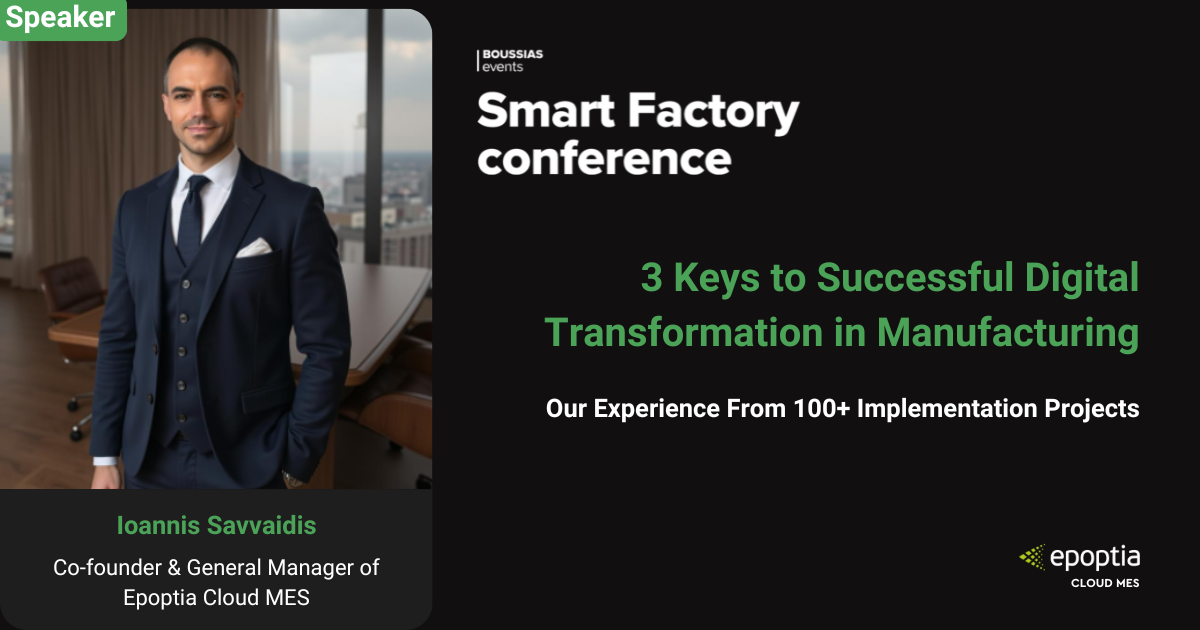Η εμπειρία μας από 100+ έργα υλοποίησης
Αρχικά, στην Epoptia, έχουμε εφαρμόσει με επιτυχία λύσεις ψηφιακού μετασχηματισμού για περισσότερους από 100 κατασκευαστές σε διάφορους κλάδους παγκοσμίως. Κατά τη διάρκεια μιας πρόσφατης συνέντευξης στο Smart Factory Conference 2025, ο συνιδρυτής και γενικός διευθυντής μας Ιωάννης Σαββαΐδης μοιράστηκε πολύτιμες πληροφορίες σχετικά με το τι πραγματικά κάνει αυτά τα έργα να πετύχουν, όταν οι στατιστικές του κλάδου δείχνουν ότι περίπου 65-70% συνήθως αποτυγχάνουν να αποδώσουν τα αναμενόμενα αποτελέσματα.
Επιπλέον, μέσω της εκτεταμένης εμπειρίας μας, έχουμε εντοπίσει πρότυπα και στρατηγικές που οδηγούν σταθερά σε επιτυχή αποτελέσματα ψηφιακού μετασχηματισμού. Αυτές οι γνώσεις δεν προέρχονται από θεωρητικά πλαίσια, αλλά από πραγματικές εφαρμογές σε απαιτητικά περιβάλλοντα παραγωγής.
Δείτε ολόκληρη τη συνέντευξη εδώ
Γεννήθηκε από πραγματικές ανάγκες παραγωγής
Σε αντίθεση με πολλές λύσεις λογισμικού που δημιουργήθηκαν σε τεχνολογικές φούσκες, η Epoptia αναδύθηκε απευθείας από πραγματικές προκλήσεις στο χώρο του καταστήματος. Όταν ο ιδρυτής μας, ο Σπύρος Τσικόπουλος, διαχειριζόταν την οικογενειακή επιχείρηση παραγωγής, βρέθηκε να πνίγεται στη γραφειοκρατία, ενώ προσπαθούσε να διαχειριστεί αποτελεσματικά 30 υπαλλήλους και να αναπτύξει ταυτόχρονα την εταιρεία.
Αφού έψαξε εκτενώς για κατάλληλες λύσεις, ανακάλυψε ένα σημαντικό κενό στην αγορά για λογισμικό ειδικά σχεδιασμένο για εργαστήρια και περιβάλλοντα συναρμολόγησης. Κατά συνέπεια, μεταξύ 2011 και 2017, δημιούργησε τη δική του λύση από το μηδέν, δουλεύοντας απευθείας μαζί με τους χειριστές για να διασφαλίσει την πρακτική χρηστικότητα σε πραγματικές συνθήκες παραγωγής.
Από τότε που ξεκινήσαμε επίσημα ως εταιρεία το 2018, έχουμε επεκτείνει σημαντικά την εμβέλειά μας για να εξυπηρετούμε κατασκευαστές σε όλη την Ελλάδα, τις Ηνωμένες Πολιτείες, το Ηνωμένο Βασίλειο, την Κροατία και πέραν αυτής. Επιπλέον, το χαρτοφυλάκιο πελατών μας περιλαμβάνει πλέον ηγέτες του κλάδου, όπως η Sunlight, η Kleemann, η γερμανική εταιρεία Triathlon και η Forth Innovation στο Ηνωμένο Βασίλειο, μεταξύ πολλών άλλων. Επιπλέον, κάθε μία από αυτές τις υλοποιήσεις έχει βελτιώσει περαιτέρω την κατανόηση των προκλήσεων της παραγωγής σε διαφορετικά περιβάλλοντα.
Γιατί η εμπλοκή των χειριστών κάνει ή χαλάει τα έργα
Κατά τη διάρκεια της εμπειρίας μας στην υλοποίηση, έχουμε διαπιστώσει σταθερά ότι η μεγαλύτερη ανησυχία των κατασκευαστών είναι απλή αλλά και βαθιά: “Θα χρησιμοποιήσουν οι χειριστές μου το σύστημα;”
Η ανησυχία αυτή είναι απολύτως δικαιολογημένη. Στα περισσότερα κατασκευαστικά περιβάλλοντα, οι χειριστές ποικίλλουν ευρέως ως προς τις τεχνικές τους ικανότητες - από άτομα με τεχνολογικές γνώσεις μέχρι άτομα που χρησιμοποιούν ελάχιστα smartphones στην καθημερινή τους ζωή. Ως εκ τούτου, η γεφύρωση αυτού του χάσματος είναι απαραίτητη για την επιτυχία του έργου.
Η προσέγγισή μας για την επίτευξη του αξιοσημείωτου ποσοστού επιτυχίας της εφαρμογής 99% επικεντρώνεται σε τρεις αλληλένδετες στρατηγικές:
1. Σχεδιάστε συστήματα που βοηθούν, όχι πιέζουν
Πρώτα απ' όλα, τα ψηφιακά εργαλεία θα πρέπει να διευκολύνουν την εργασία των χειριστών και όχι να τους προσθέτουν επιπλέον βάρος. Πολλά συστήματα αποτυγχάνουν επειδή μοιάζουν με επιτήρηση ή πρόσθετη εργασία αντί για βοήθεια.
2. Ενσωματώστε οικεία στοιχεία
Επιπλέον, ενσωματώνουμε πάντα σχέδια, φύλλα προδιαγραφών ή άλλα υλικά με τα οποία οι χειριστές εργάζονται ήδη καθημερινά. Αυτό δημιουργεί μια άμεση αίσθηση εξοικείωσης και πρακτικής αξίας, η οποία αυξάνει σημαντικά τα ποσοστά υιοθέτησης.
3. Επικύρωση των ανησυχιών του χειριστή
Επιπλέον, χρησιμοποιούμε το σύστημα για την τεκμηρίωση και τη μέτρηση ζητημάτων που οι χειριστές μπορεί να είχαν αναφέρει προηγουμένως, αλλά η διοίκηση δεν είχε λάβει υπόψη της. Αυτή η επικύρωση δημιουργεί εμπιστοσύνη και αποδεικνύει την αξία του συστήματος ως εργαλείο επικοινωνίας.
Ως αποτέλεσμα αυτής της προσεκτικής προσέγγισης, έχουμε εμπλέξει με επιτυχία πάνω από 2.500 φορείς παγκοσμίως με την πλατφόρμα μας, μετατρέποντας την πιθανή αντίσταση σε ενθουσιώδη υιοθέτηση.
3 πυλώνες για βιώσιμη εφαρμογή
Ο ψηφιακός μετασχηματισμός δεν είναι απλώς ένα εφάπαξ έργο, αλλά μάλλον ένα συνεχές ταξίδι που απαιτεί βιώσιμες προσεγγίσεις. Με βάση την εκτεταμένη εμπειρία μας, έχουμε εντοπίσει τρεις βασικούς πυλώνες που υποστηρίζουν τη μακροπρόθεσμη επιτυχία:
1. Στρατηγική συμβουλευτική
Πρώτον, βοηθάμε τους κατασκευαστές να κατανοήσουν ότι η μετάβαση από την τρέχουσα κατάσταση στην επιθυμητή μελλοντική κατάσταση απαιτεί μεθοδικά ενδιάμεσα βήματα. Για παράδειγμα, όταν ένας πελάτης με ένα ανεκμετάλλευτο σύστημα ERP μας είπε πρόσφατα ότι ήθελε ολοκληρωμένη παρακολούθηση ακόμη και μικρών εξαρτημάτων, του εξηγήσαμε ότι η πρώτη εφαρμογή βασικών λειτουργιών αποθήκης ήταν απαραίτητη προϋπόθεση. Μέσω αυτής της συμβουλευτικής προσέγγισης, δημιουργούμε ρεαλιστικούς οδικούς χάρτες με βάση την τρέχουσα πραγματικότητα κάθε εταιρείας και όχι επιβάλλοντας εξιδανικευμένες αλλά μη πρακτικές λύσεις.
2. Ευέλικτο λογισμικό
Επιπλέον, καθώς οι εταιρείες εξελίσσονται με την πάροδο του χρόνου - προσθέτοντας νέα μηχανήματα, αλλάζοντας ροές εργασίας ή αναδιαρθρώνοντας ομάδες - το λογισμικό πρέπει να προσαρμόζεται χωρίς να απαιτούνται δαπανηρές ανακατασκευές. Κατά συνέπεια, η πλατφόρμα μας προσφέρει αυτή την ευελιξία από το σχεδιασμό της, δίνοντας τη δυνατότητα στους πελάτες να αναπτύσσονται οργανικά, ενώ τα συστήματά τους εξελίσσονται μαζί τους.
3. Επιχειρησιακή επεκτασιμότητα
Επιπλέον, για τους μεγαλύτερους πελάτες που διαχειρίζονται πολλαπλές εγκαταστάσεις, το σύστημά μας παρέχει ένα συνεπές θεμέλιο που μπορεί να επεκταθεί σε όλες τις τοποθεσίες χωρίς να ξεκινάει από το μηδέν κάθε φορά. Αυτό επιτρέπει τυποποιημένες διαδικασίες, ενώ παράλληλα προσαρμόζεται στις απαιτήσεις των συγκεκριμένων χώρων - μια ισορροπία που είναι ζωτικής σημασίας για τις επιχειρήσεις πολλαπλών χώρων.
Ο ανθρώπινος παράγοντας: Επιλέξτε τους συνεργάτες σας με σύνεση
Η πιο κρίσιμη συμβουλή μας για τους κατασκευαστές που ξεκινούν το ταξίδι του ψηφιακού μετασχηματισμού; Η επιτυχία εξαρτάται τελικά τόσο από τους ανθρώπους όσο και από την τεχνολογία.
Συγκεκριμένα, είναι σημαντικό να επιλέξετε εσωτερικούς πρωταθλητές που κατανοούν τόσο τις τεχνολογικές δυνατότητες όσο και την πραγματικότητα της παραγωγής. Τα άτομα αυτά λειτουργούν ως γέφυρες μεταξύ διαφορετικών τμημάτων και προοπτικών. Ομοίως, κατά την επιλογή εξωτερικών συνεργατών, δώστε προτεραιότητα σε εκείνους που διαθέτουν άμεση εμπειρία στο συγκεκριμένο περιβάλλον παραγωγής σας και μιλούν πραγματικά τη γλώσσα σας.
Τουλάχιστον, βεβαιωθείτε ότι ο τεχνολογικός σας συνεργάτης επιδεικνύει γνήσια προθυμία να κάνει το κάτι παραπάνω για την επιτυχία σας. Χωρίς αυτή τη δέσμευση, το έργο σας κινδυνεύει να γίνει ένα ακόμη στατιστικό στοιχείο στο υψηλό ποσοστό αποτυχίας των πρωτοβουλιών ψηφιακού μετασχηματισμού.
Συμπέρασμα
Συνοψίζοντας, στο Το Epoptia, η βαθιά μας κατανόηση των εργασιών εργοστασίου και συναρμολόγησης, σε συνδυασμό με την εστίασή μας στις στρατηγικές υλοποίησης με επίκεντρο τον άνθρωπο, συνεχίζει να φέρνει εξαιρετικά αποτελέσματα εκεί που οι άλλοι αποτυγχάνουν. Αντιμετωπίζοντας από κοινού τα τεχνικά, λειτουργικά και ανθρώπινα στοιχεία του ψηφιακού μετασχηματισμού, έχουμε βοηθήσει κατασκευαστές σε διάφορους κλάδους να επιτύχουν διαρκείς βελτιώσεις στην παραγωγικότητα, την ποιότητα και τη λειτουργική ορατότητα.
Το ψηφιακό μέλλον της μεταποίησης ανήκει σε εκείνους που μπορούν να γεφυρώσουν με επιτυχία το χάσμα μεταξύ της προηγμένης τεχνολογίας και της πραγματικότητας στο χώρο του εργοστασίου - και είμαστε υπερήφανοι που πρωτοστατούμε σε αυτή την κρίσιμη εξέλιξη.
Για περισσότερες πληροφορίες, δείτε https://bit.ly/3vYnb4f.
Αυτό το άρθρο βασίζεται στη συνέντευξη του Ιωάννη Σαββαΐδη, συνιδρυτή και γενικού διευθυντή της Epoptia, στο Smart Factory Conference 2025.




















